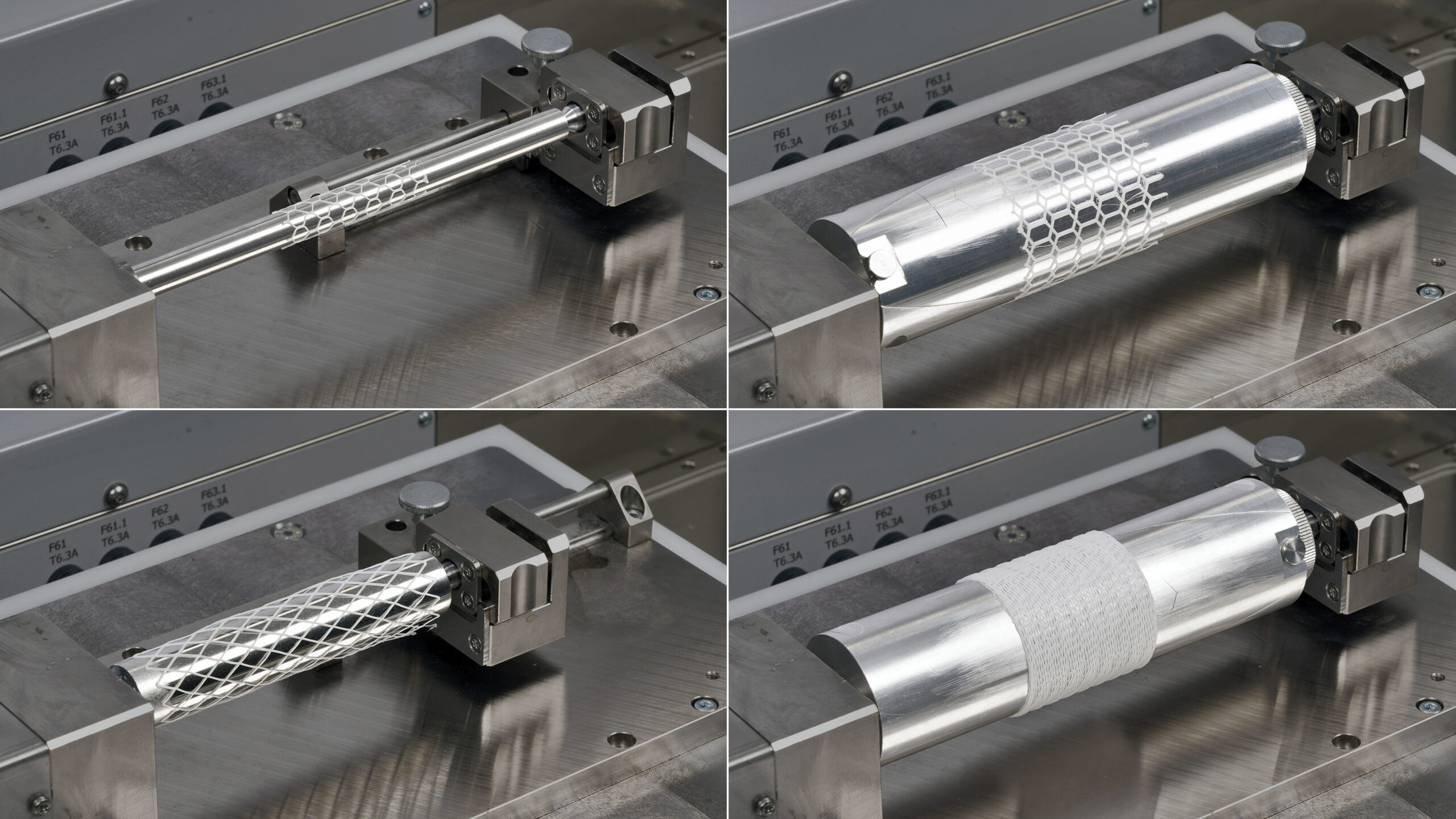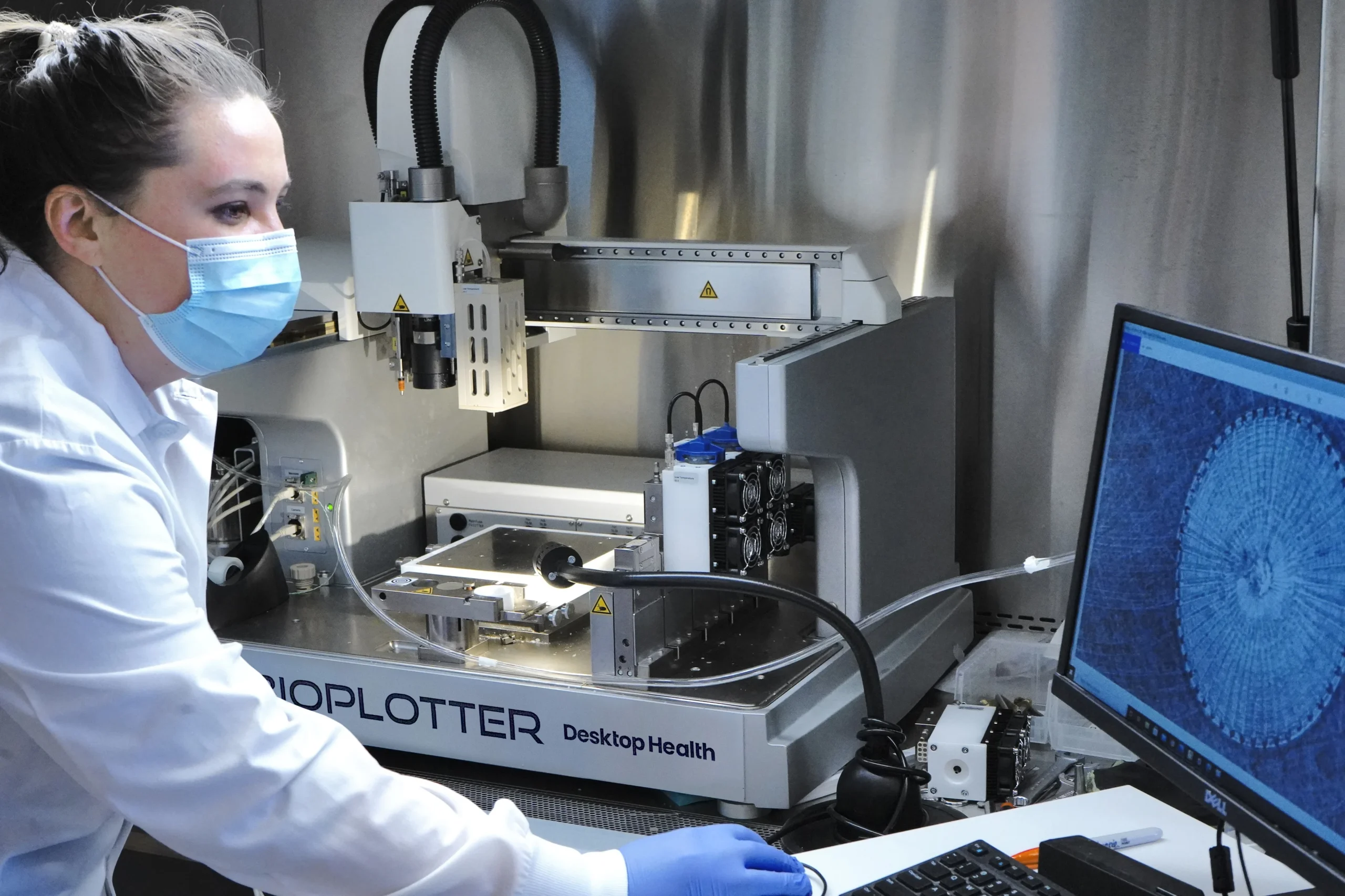Desktop Health, the medical 3D printing division of Desktop Metal (NYSE: DM), has unveiled a new tool called PrintRoll. This first-of-its-kind bioprinting tool is an attachment for their 3D printer known as the 3D-Bioplotter. What’s unique about the PrintRoll rotating add-on feature? It lets the 3D bioprinter create complex tube-shaped medical devices of different diameters, customized to the needs of young and adult patients, that can potentially be used in our body’s systems for vascular, digestive, respiratory, and reproductive channels – such as blood vessels, airways, and digestive tracts.

Desktop Health’s PrintRoll rotating build platform for the 3D-Bioplotter. Image courtesy of Business Wire.
According to the brand, PrintRoll isn’t merely a novel feature; it represents a vision where intricate medical solutions can be fashioned with unprecedented precision. This unique rolling substrate, co-developed with the renowned public research university Johannes Gutenberg University Mainz in Germany since 2019, is engineered to create complex cylindrical devices such as vascular grafts, wound dressings, and stents.
PrintRoll is an attachment for the 3D-Bioplotter that uses rotating drums to print. Perhaps we could think of it like a pottery wheel but for 3D printing. The speed at which it rotates is managed by user-friendly software. As it turns, the printer adds material onto it in specific patterns. One common material used is a special medical biodegradable plastic, polycaprolactone (PCL), which hardens fast after printing (See video below). This material is often used to create supports or structures that can integrate with the body and sometimes dissolve over time.
The PrintRoll can print on drums of different sizes, from as small as 10 mm to as large as 40 mm in diameter. These sizes are chosen to match different body parts, such as arteries or trachea, which change from person to person. Additionally, it can print long hollow tubes up to 140 mm, depending on the printer head chosen, with even more size options possibly available upon request.
Nicole Black, VP of Biomaterials and Innovation at Desktop Health, explains the platform’s capabilities: “Up until now, the creation of thin-walled cylindrical devices with complex structured walls has been challenging to accomplish with regenerative materials, such as hydrogels. With the PrintRoll, materials are patterned directly on top of a substrate that rolls as the printhead also moves, supporting the deposited layers and therefore expanding the palette of materials that can be 3D printed into these important structures. Following printing, devices can be removed from the PrintRoll, leaving high-resolution and reproducible parts that customers have come to expect from the 3D-Bioplotter.”
Bioprinting legacy
The 3D-Bioplotter has been a trusted tool in the bioprinting community for many years. But, It’s not just about its years in the market; it’s also about its contribution to science. In fact, the 3D-Bioplotter is the world’s most cited and researched bioprinter, boasting over 2,490 citations and 600 research papers produced directly with the system. One example from 2022 is from the Hannover Medical School in Germany, which showcased the printer’s clinical application by publishing a report on a successfully implanted 3D-Bioplotter printed part in a child’s ear canal, resulting in a favorable outcome for the patient.
Its newest feature, the PrintRoll platform, is part of Desktop Health’s efforts to advance its technology. Among its achievements, the 3D-Bioplotter is recognized for its early entry into the commercial bioprinting market. Other recent milestones include the U.S. Food and Drug Administration (FDA) ‘s 510(k) clearance Chicago-based Dimension Inx for its CMFlex, a bone graft substitute regeneration product developed and manufactured on the 3D-Bioplotter. CMFlex is described as a flexible, 3D printed alternative to traditional autografts, eliminating the need to “intrusively harvest bone from one part of a patient’s body to treat another.”
“The recent FDA clearance of CMFlex by Dimension Inx is a breakthrough for the field of additive, regenerative medicine – one that clearly showcases the robustness of the 3D-Bioplotter,” said Lou Azzarra, President of Desktop Health. “Commercial milestones like this often take many years, and we congratulate the entire team at Dimension Inx on this achievement.”
Promising horizon
Ric Fulop, Founder and CEO of Desktop Metal, had this to say about the company’s vision: “We are proud to offer the first bioprinting tool specifically designed to develop medical solutions for the thousands of miles of channels found in the human body. Desktop Health exists to deliver 3D printing solutions that improve patient lives, and we are confident that PrintRoll, offered exclusively on the 3D-Bioplotter, will enable all-new regenerative innovations. We look forward to seeing what our customers will create next with this exciting new tool.”
The PrintRoll platform is now available for pre-order, with deliveries slated for the fourth quarter of 2023. In an age where personalized healthcare solutions are crucial, innovations like the 3D-Bioplotter with the PrintRoll platform are not just technological breakthroughs but signs of promise for countless patients worldwide.
Subscribe to Our Email Newsletter
Stay up-to-date on all the latest news from the 3D printing industry and receive information and offers from third party vendors.
You May Also Like
Further Understanding of 3D Printing Design at ADDITIV Design World
ADDITIV is back once again! This time, the virtual platform for additive manufacturing will be holding the first-ever edition of ADDITIV Design World on May 23rd from 9:00 AM –...
3D Printer Maker EVO-tech Reborn as NEVO3D — Once More With Feeling
EVO-tech was a 3D printing service and original equipment manufacturer established in 2013 and based in Schörfling am Attersee, Austria. The company produced high-quality material extrusion systems featuring linear bearings,...
3D Systems Brings 3D Printed PEEK Cranial Implant to the U.S. with FDA Clearance
For more than 10 years, 3D Systems (NYSE:DDD) has worked hand-in-hand with surgeons to plan over 150,000 patient-specific cases, and develop more than two million instruments and implants from its...
CDFAM Returns to Berlin for Second Annual Symposium
The second CDFAM Computational Design Symposium is scheduled for May 7-8, 2024, in Berlin, and will convene leading experts in computational design across all scales. Building upon the first event...
































